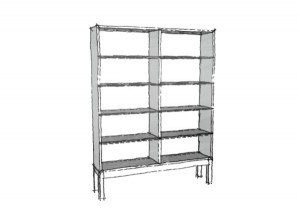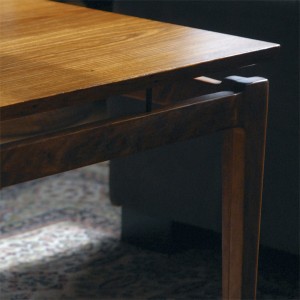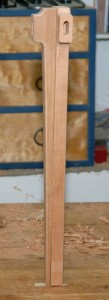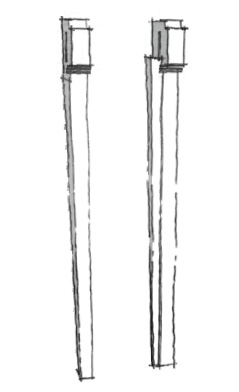My friends admired a bookcase by the Danish designer Børge Mogensen–and rightfully so: the stand-on-case design features a subtle interplay of details–between the case and top, between the varying thickness of stock, and between the shelf and case depth–that distinguish the piece. Unfortunately, the second floor of their one-and-a-half-story Craftsman bungalow couldn’t accommodate the case’s 63″ height. Clearly a shorter case was needed, but simply eliminating a couple of shelves while preserving the width of the original would create an ungainly design, an ill-proportioned stumpy case. Continue reading
Tag Archives: Mid-Century Modern
Finn Juhl-inspired Coffee Table–Construction
Construction began with the top. I cut a 3/4″ plywood panel 1/4″ undersized to account for the 1/8″ edge banding with my tracksaw set at angle to cut the bevel. After ripping stock into 1/8″ strips, I spread a bead of glue along the short plywood edges and gave it a minute to size the join, then applied another thin bead of glue and taped the banding in place with painter’s tape. When the glue dried, I trimmed the banding and then banded the long sides. While the glue dried, I cut the pattern for the legs and shaped it to final size, then roughed out leg blanks and routed them to final size. I’m glad I cut extra blanks since I destroyed several while trying to rout the curve of the stub out–the short grain is prone to blowout. Continue reading
Juhl Coffee Table–Final Leg Design
After considering a couple of 3D models of the leg options, I built the basic leg since I could always modify it. After routing out the first of the legs for the table, I decided the simple 3/4″ thick option wouldn’t look as good as a variation on the laminated leg. A practical consideration underlines the visual appeal of the laminated leg as well–the extra depth provides a better seat for the apron tenons. Instead of a simple triangular piece glued to the main leg, I sawed down a copy of the main leg to produce a slimmer profile. This has the the benefit of producing depth for the stretcher tenon. The edge of the piece is rabbeted to produce a 1/4″ tongue that is house in a corresponding groove in the main leg.
A Tale of Two Legs
It turns out I didn’t have to look far to find an alternative to the turned legs in the Juhl coffee table I’m working on. There’s a tapered leg Juhl used in an ottoman design and in a coffee table design. While I’m contemplating a variation, though, I may as well contemplate a variation on that variation. I like the accent strip featured on the inside of the leg since it gives that profile a little more dimensionality. It also helps balance the structure.
The taper, though, calls to mind some Shaker designs, and I find myself considering eliminating the strip and beveling the leg from 3/4″ thickness at the top to 1/2″ at the bottom. The side stretcher looks a little less grounded, then, but the stark taper isn’t without its appeal, and it’s also easier to execute. Decisions, decisions.
Finn Juhl Coffee Table–Design
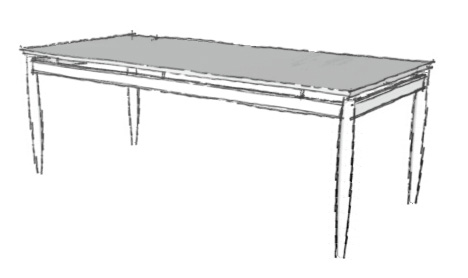
Finn Juhl’s design features a beveled top suspended above a simple base distinguished by turned, tapered legs.
For my next project I’m jumping out of my usual Arts & Crafts period work several decades to build a Mid-century Modern coffee table by the Danish designer Finn Juhl. Juhl’s table features a beveled top suspended above its base by six dowels. Turned, tapered legs distinguish the rectilinear base.
The coffee table, along with sideboard, is perhaps the signature piece of mid-Century furniture, in much the same way the Morris chair has become emblematic of Arts & Crafts furniture. And Juhl’s table is an intriguing example of the form. He used the floating top elsewhere in his designs, but more often in his chairs, making its appearance as a table top a bit of an aberration. The original was built of teak, but I’m contemplating a version in fir or cherry, depending how closely I want to hew to the original construction, which features a veneered top banded with solid wood edging. If I follow suit, I’ll use some cherry plywood left over from an old project. If I opt for a solid wood top, I’ll be able to use some wide fir boards I picked up when a local sawyer moved shop to Alaska. Of course a solid wood top creates the potential for movement problems with seasonal changes in humidity, but I think there’s enough flex in how the top joins the base to absorb that movement. Continue reading

